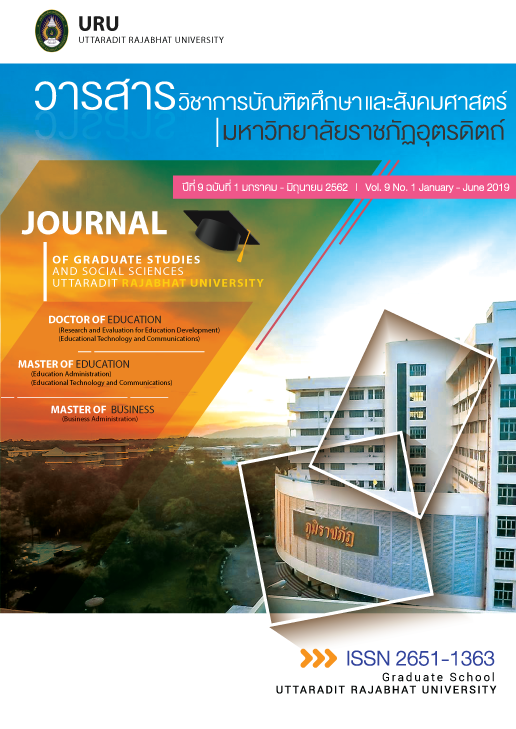The Development THE DEVELOPMENT OF 21ST CENTURY SCIENCE’S PROCESS SKILLS TEST FOR PRIMARY STUDENTS
Keywords:
The Science Process Skills Test, 21st Century SkillsAbstract
Abstract
The purpose of this research were to develop the factors and indicators, science process skills test, and norms of science process skills in the 21st century for primary students. The population used to study was primary school students all over the country in the year 2017. The sample was 2,190 primary students in grade 6 who were drawn by using the multistage random sampling. The instrument used in the research was a 30 – item- written test dealing with science process skills, multiple choice test and short answer test. On the test taker has two choices to choose from. Data were analyzed by SPSS program to factor Analysis.
The results showed that 2 components in the development of elements and indicators of scientific process measurement skills in the 21st Century for elementary students : basic learning process and advanced thinking process. For the basic elements, the learning process has 8 indicators, including : observation, measurement, using numbers, classifying, space/space relationship and space/time relationship, communication, predicting, inferring and there are 5 indicators of thinking process elements, including : formulating hypothesis, defining operationally, control variables, experimenting and interpreting /conclusions. The total score of 30 items was 0.451 to 0.871 and the mean score was 0.371 and statistically significant at 0.01. The coefficient of prediction (R2) is between 0.203 and 0.759
The quality of the 21st Century Science Process Skills for students in primary school were 30 items with the p - value was between 0.300 - 0.830. The r - value was between 0.200 - 0.890. The reliability of 0.938.
Normal Criteria for the 21st Century science process skills model for primary school students were interpreted as normative meanings. (standardized score norms) of the whole scientific process skills measurement. The edition was divided into 9 levels. From standard score 9 (Stanine System) as follows: If the student reached a score of more than 125 in the grade level, the student gets an excellent science process skills, if the score level is 119 – 125 it indicates that the student has very good science process skills (26.94 %), if the score level is 112 – 118 it indicates that student has a good scientific process skills (20.09%), a score of 104 - 111 indicates that the students has an average scientific process skills (18.81%) , grade point average of 97 - 103 indicates that the student has moderate scientific process skills (12.60%), a grade level of 90 - 96 indicates that the student has less than moderate scientific process skills (7.76%), the score range from 83 - 89 indicates that the student has low scientific process skills (7.85%), grades 77 - 82 show that the student has a very poor scientific process skills (5.94%), a score of less than 77 indicates that the student has the lowest science process skills.
References
กระทรวงศึกษาธิการ. (2552). แนวปฏิบัติการวัดและประเมินผลการเรียนรู้. กรุงเทพฯ: โรงพิมพ์ชุมนุมสหกรณ์การเกษตรแห่งประเทศไทย.
กระทรวงศึกษาธิการ. (2553). หลักสูตรแกนกลางการศึกษาขั้นพื้นฐาน พุทธศักราช 2551. (พิมพ์ครั้งที่ 3). กรุงเทพฯ : โรงพิมพ์ชุมนุมสหกรณ์การเกษตรแห่งประเทศไทย.
กัลยา วานิชย์บัญชา. (2553). การวิเคราะห์สถิติขั้นสูงด้วย SPSS for Window. (พิมพ์ครั้งที่ 6). กรุงเทพฯ : จุฬาลงกรณ์มหาวิทยาลัย.
ชาญวิทย์ จรัสสุทธิอิศร. (2545). การพัฒนากฏเกณฑ์การให้คะแนนทักษะกระบวนการทางวิทยาศาสตร์ขั้นบูรณาการ. (วิทยานิพนธ์ปริญญามหาบัณฑิต). กรุงเทพฯ: มหาวิทยาลัยศรีนครินทรวิโรฒ.
ทิพยวรรณ์ ไกรนรา. (2550). ชุดฝึกทักษะกระบวนการทางวิทยาศาสตร์ขั้นผสม เพื่อพัฒนาผลสัมฤทธิ์ด้านทักษะกระบวนการทางวิทยาศาสตร์ขั้นผสม สำหรับนักเรียนชั้นมัธยมศึกษาปีที่ 1. (วิทยานิพนธ์ปริญญามหาบัณฑิต). กรุงเทพฯ: มหาวิทยาลัยเกษตรศาสตร์.
บุปผา จุลพันธ์. (2550). การศึกษาความสัมพันธ์ระหว่างปัจจัยบางประการกับทักษะกระบวนการทางวิทยาศาสตร์ขั้นพื้นฐานของนักเรียนชั้นประถมศึกษาปีที่ 6 ในโรงเรียนสังกัดกรุงเทพมหานคร. (วิทยานิพนธ์ปริญญามหาบัณฑิต). กรุงเทพฯ: มหาวิทยาลัยศรีนครินทรวิโรฒ.
ระพินทร์ โพธิ์ศรี. (2536). เกณฑ์ปกติและการเทียบคะแนน. อุตรดิตถ์ : สถาบันราชภัฎอุตรดิตถ์.
แรมสมร อยู่สถาพร. (2551). เทคนิคและวิธีสอนในระดับประถมศึกษา. กรุงเทพฯ : จุฬาลงกรณ์มหาวิทยาลัย.
วรรณทิพา รอดแรงค้า. (2544). การสอนวิทยาศาสตร์ที่เน้นทักษะกระบวนการ. กรุงเทพฯ : โรงพิมพ์สถาบันพัฒนาคุณภาพวิชาการ (พว.)
ศิริชัย กาญจนวาสี. (2550). ทฤษฎีการทดสอบแนวใหม่. (พิมพ์ครั้งที่ 3). กรุงเทพฯ: จุฬาลงกรณ์มหาวิทยาลัย.
ส่งเสริมการสอนวิทยาศาสตร์และเทคโนโลยี, สถาบัน (2546). คู่มือวัดผลประเมินผลวิทยาศาสตร์. กรุงเทพฯ: สถาบันส่งเสริมการสอนวิทยาศาสตร์และเทคโนโลยี.
สมนึก ภัททิยธนี. (2555). การวัดผลการศึกษา. (พิมพ์ครั้งที่ 8). กาฬสินธุ์ : ประสานการพิมพ์.
สุกัญญา ทองนาค. (2555). การพัฒนาแบบทดสอบสมรรถนะนักศึกษาตามมาตรฐานวิชาชีพครูแบบพหุมิติที่มีการตรวจให้คะแนนแบบพหุภาค. (วิทยานิพนธ์ปริญญาดุษฎีบัณฑิต). กรุงเทพฯ: จุฬาลงกรณ์มหาวิทยาลัย.
สุดารัตน์ วิไลวรรณ. (2551). การศึกษาทักษะกระบวนการทางวิทยาศาสตร์ขั้นพื้นฐานของนักเรียนชั้นมัธยม ศึกษาปีที่ 2 ที่มีการคิดต่างกัน ในโรงเรียนขยายโอกาสทางการศึกษา กลุ่มเจ้าพระยา สังกัดกรุงเทพมหานคร. (วิทยานิพนธ์ปริญญา
มหาบัณฑิต). กรุงเทพฯ: มหาวิทยาลัยศรีนครินทรวิโรฒ.
สุภมาส อังศุโชติ, สมถวิล วิจิตรวรรณา และรัชนีกูล ภิญโญ ภานุวัฒน์. (2554). สถิติวิเคราะห์สำหรับการวิจัยทาง สังคมศาสตร์และพฤติกรรมศาสตร์เทคนิคการใช้โปรแกรม LISREL. (พิมพ์ครั้งที่ 3). กรุงเทพฯ: เจริญดีมั่นคง.
อัญชลี เหล่ารอด. (2554). ผลการพัฒนาทักษะกระบวนการทางวิทยาศาสตร์ขั้นพื้นฐานของนักเรียมัธยมศึกษา ปีที่ 3 โดยใช้คำถามควบคู่กับการจัดการเรียนรู้กลุ่มสาระการเรียนรู้วิทยาศาสตร์. กรุงเทพฯ: บัณฑิตวิทยาลัย มหาวิทยาลัยศรีนครินทรวิโรฒ.
Abruscato, J. (2000). Teaching Children Science. Messachusetts: Allyn & Bacon.
Kiopfer, Leopard E. (1974). Evaluation of Learning in Science. In Handbook on Formative Evaluation of Student Learning.
Published
How to Cite
Issue
Section
License
แนวคิดและทัศนะในบทความเป็นความรับผิดชอบของผู้เขียนบทความ การนำบทความหรือส่วนหนึ่งของบทความไปตีพิมพ์เผยแพร่ ให้อ้างอิงแสดงที่มา และข้อมูลเกี่ยวกับผู้เขียนบทความ



